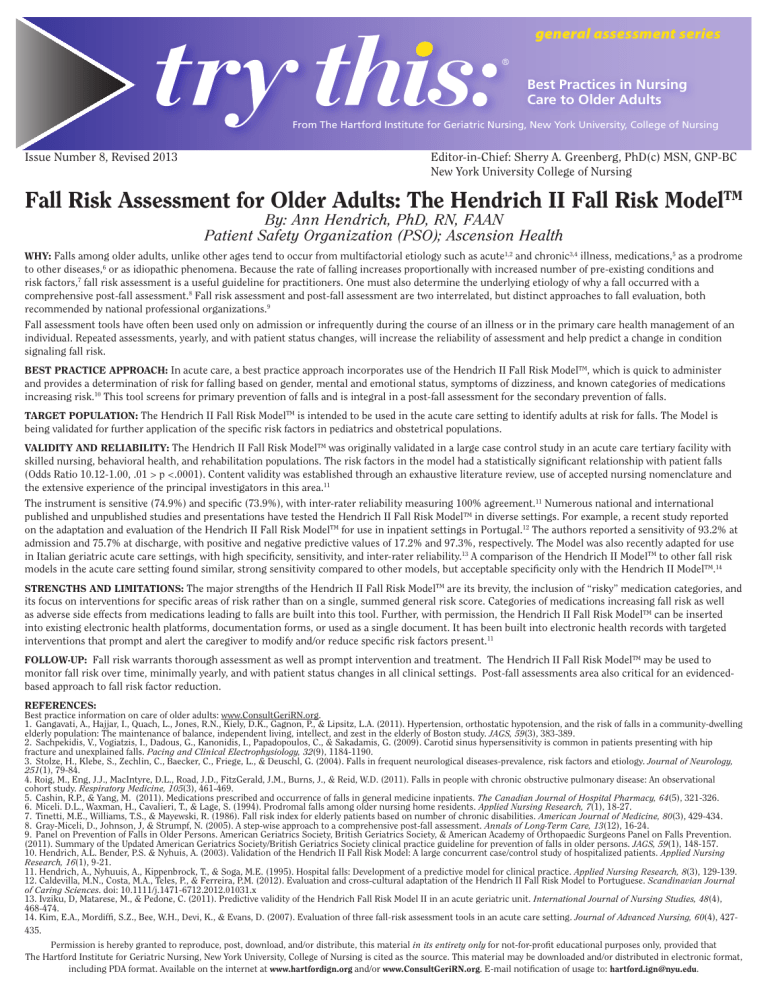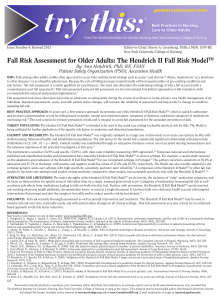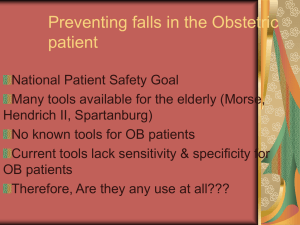Hendrich II Fall Risk Model: Fall Assessment for Older Adults
advertisement

general assessment series Best Practices in Nursing Care to Older Adults From The Hartford Institute for Geriatric Nursing, New York University, College of Nursing Issue Number 8, Revised 2013 Editor-in-Chief: Sherry A. Greenberg, PhD(c) MSN, GNP-BC New York University College of Nursing Fall Risk Assessment for Older Adults: The Hendrich II Fall Risk ModelTM By: Ann Hendrich, PhD, RN, FAAN Patient Safety Organization (PSO); Ascension Health WHY: Falls among older adults, unlike other ages tend to occur from multifactorial etiology such as acute1,2 and chronic3,4 illness, medications,5 as a prodrome to other diseases,6 or as idiopathic phenomena. Because the rate of falling increases proportionally with increased number of pre-existing conditions and risk factors,7 fall risk assessment is a useful guideline for practitioners. One must also determine the underlying etiology of why a fall occurred with a comprehensive post-fall assessment.8 Fall risk assessment and post-fall assessment are two interrelated, but distinct approaches to fall evaluation, both recommended by national professional organizations.9 Fall assessment tools have often been used only on admission or infrequently during the course of an illness or in the primary care health management of an individual. Repeated assessments, yearly, and with patient status changes, will increase the reliability of assessment and help predict a change in condition signaling fall risk. BEST PRACTICE APPROACH: In acute care, a best practice approach incorporates use of the Hendrich II Fall Risk ModelTM, which is quick to administer and provides a determination of risk for falling based on gender, mental and emotional status, symptoms of dizziness, and known categories of medications increasing risk.10 This tool screens for primary prevention of falls and is integral in a post-fall assessment for the secondary prevention of falls. TARGET POPULATION: The Hendrich II Fall Risk ModelTM is intended to be used in the acute care setting to identify adults at risk for falls. The Model is being validated for further application of the specific risk factors in pediatrics and obstetrical populations. VALIDITY AND RELIABILITY: The Hendrich II Fall Risk ModelTM was originally validated in a large case control study in an acute care tertiary facility with skilled nursing, behavioral health, and rehabilitation populations. The risk factors in the model had a statistically significant relationship with patient falls (Odds Ratio 10.12-1.00, .01 > p <.0001). Content validity was established through an exhaustive literature review, use of accepted nursing nomenclature and the extensive experience of the principal investigators in this area.11 The instrument is sensitive (74.9%) and specific (73.9%), with inter-rater reliability measuring 100% agreement.11 Numerous national and international published and unpublished studies and presentations have tested the Hendrich II Fall Risk ModelTM in diverse settings. For example, a recent study reported on the adaptation and evaluation of the Hendrich II Fall Risk ModelTM for use in inpatient settings in Portugal.12 The authors reported a sensitivity of 93.2% at admission and 75.7% at discharge, with positive and negative predictive values of 17.2% and 97.3%, respectively. The Model was also recently adapted for use in Italian geriatric acute care settings, with high specificity, sensitivity, and inter-rater reliability.13 A comparison of the Hendrich II ModelTM to other fall risk models in the acute care setting found similar, strong sensitivity compared to other models, but acceptable specificity only with the Hendrich II ModelTM.14 STRENGTHS AND LIMITATIONS: The major strengths of the Hendrich II Fall Risk ModelTM are its brevity, the inclusion of “risky” medication categories, and its focus on interventions for specific areas of risk rather than on a single, summed general risk score. Categories of medications increasing fall risk as well as adverse side effects from medications leading to falls are built into this tool. Further, with permission, the Hendrich II Fall Risk ModelTM can be inserted into existing electronic health platforms, documentation forms, or used as a single document. It has been built into electronic health records with targeted interventions that prompt and alert the caregiver to modify and/or reduce specific risk factors present.11 FOLLOW-UP: Fall risk warrants thorough assessment as well as prompt intervention and treatment. The Hendrich II Fall Risk ModelTM may be used to monitor fall risk over time, minimally yearly, and with patient status changes in all clinical settings. Post-fall assessments area also critical for an evidencedbased approach to fall risk factor reduction. REFERENCES: Best practice information on care of older adults: www.ConsultGeriRN.org. 1. Gangavati, A., Hajjar, I., Quach, L., Jones, R.N., Kiely, D.K., Gagnon, P., & Lipsitz, L.A. (2011). Hypertension, orthostatic hypotension, and the risk of falls in a community-dwelling elderly population: The maintenance of balance, independent living, intellect, and zest in the elderly of Boston study. JAGS, 59(3), 383-389. 2. Sachpekidis, V., Vogiatzis, I., Dadous, G., Kanonidis, I., Papadopoulos, C., & Sakadamis, G. (2009). Carotid sinus hypersensitivity is common in patients presenting with hip fracture and unexplained falls. Pacing and Clinical Electrophysiology, 32(9), 1184-1190. 3. Stolze, H., Klebe, S., Zechlin, C., Baecker, C., Friege, L., & Deuschl, G. (2004). Falls in frequent neurological diseases-prevalence, risk factors and etiology. Journal of Neurology, 251(1), 79-84. 4. Roig, M., Eng, J.J., MacIntyre, D.L., Road, J.D., FitzGerald, J.M., Burns, J., & Reid, W.D. (2011). Falls in people with chronic obstructive pulmonary disease: An observational cohort study. Respiratory Medicine, 105(3), 461-469. 5. Cashin, R.P., & Yang, M. (2011). Medications prescribed and occurrence of falls in general medicine inpatients. The Canadian Journal of Hospital Pharmacy, 64(5), 321-326. 6. Miceli. D.L., Waxman, H., Cavalieri, T., & Lage, S. (1994). Prodromal falls among older nursing home residents. Applied Nursing Research, 7(1), 18-27. 7. Tinetti, M.E., Williams, T.S., & Mayewski, R. (1986). Fall risk index for elderly patients based on number of chronic disabilities. American Journal of Medicine, 80(3), 429-434. 8. Gray-Miceli, D., Johnson, J, & Strumpf, N. (2005). A step-wise approach to a comprehensive post-fall assessment. Annals of Long-Term Care, 13(12), 16-24. 9. Panel on Prevention of Falls in Older Persons. American Geriatrics Society, British Geriatrics Society, & American Academy of Orthopaedic Surgeons Panel on Falls Prevention. (2011). Summary of the Updated American Geriatrics Society/British Geriatrics Society clinical practice guideline for prevention of falls in older persons. JAGS, 59(1), 148-157. 10. Hendrich, A.L. Bender, P.S. & Nyhuis, A. (2003). Validation of the Hendrich II Fall Risk Model: A large concurrent case/control study of hospitalized patients. Applied Nursing Research, 16(1), 9-21. 11. Hendrich, A., Nyhuuis, A., Kippenbrock, T., & Soga, M.E. (1995). Hospital falls: Development of a predictive model for clinical practice. Applied Nursing Research, 8(3), 129-139. 12. Caldevilla, M.N., Costa, M.A., Teles, P., & Ferreira, P.M. (2012). Evaluation and cross-cultural adaptation of the Hendrich II Fall Risk Model to Portuguese. Scandinavian Journal of Caring Sciences. doi: 10.1111/j.1471-6712.2012.01031.x 13. Ivziku, D, Matarese, M., & Pedone, C. (2011). Predictive validity of the Hendrich Fall Risk Model II in an acute geriatric unit. International Journal of Nursing Studies, 48(4), 468-474. 14. Kim, E.A., Mordiffi, S.Z., Bee, W.H., Devi, K., & Evans, D. (2007). Evaluation of three fall-risk assessment tools in an acute care setting. Journal of Advanced Nursing, 60(4), 427435. Permission is hereby granted to reproduce, post, download, and/or distribute, this material in its entirety only for not-for-profit educational purposes only, provided that The Hartford Institute for Geriatric Nursing, New York University, College of Nursing is cited as the source. This material may be downloaded and/or distributed in electronic format, including PDA format. Available on the internet at www.hartfordign.org and/or www.ConsultGeriRN.org. E-mail notification of usage to: hartford.ign@nyu.edu. 1 0 0 1 0 0 0 0 0 3 4 9 The Hartford Institute would like to acknowledge the original author of this Try This:®, Deanna Gray-Miceli, DNSc, APRN, BC, FAANP general assessment series Best Practices in Nursing Care to Older Adults A series provided by The Hartford Institute for Geriatric Nursing, New York University, College of Nursing EMAIL hartford.ign@nyu.edu HARTFORD INSTITUTE WEBSITE www.hartfordign.org www.ConsultGeriRN.org CLINICAL NURSING WEBSITE

